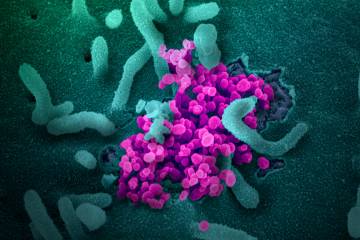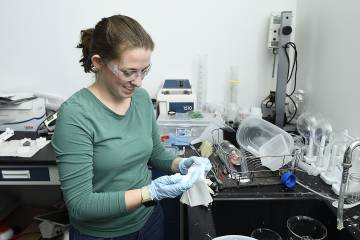When he was unable to find internships in his field owing to the pandemic, Johns Hopkins junior Harold Treminio took up babysitting to earn some cash while the university transitioned to remote learning in March. It was while babysitting that he first noticed the email from the school's Department of Chemical and Biomolecular Engineering: Now Hiring.

Image caption: Junior Harold Treminio took a job with Curative, Inc. in the fall to help test COVID-19 samples. Today he works as a supervisor in the company's plating department.
The email, forwarded from chemical and biomolecular engineerIng professor Professor Rebecca Schulman, was for open positions with Curative, a new COVID-19 testing operation that had just opened a lab in Washington, D.C., and was eager to scale up its processes in light of the growing need for reliable coronavirus testing. Founded in January 2020 as a sepsis-testing facility, Curative quickly pivoted into coronavirus testing after the U.S. reported its first cases of COVID-19. By April, the company had signed a contract to process tests from U.S. military personnel in lab space at George Washington University.
In setting up the George Washington lab, the company began recruiting employees from nearby universities to fill the need for lab technicians. An email call for applications from Curative's associate director of research Mikhail Hanewich-Hollatz was sent to friend and former colleague APL senior scientist Dan Siegal, who reached out to Schulman, who then passed the email along to the entire class.
In all, 11 Hopkins students applied for and found work in the George Washington lab, making up a large portion of the company's early class of workers. With the help of these enterprising students, Curative has grown into one of the country's major COVID-19 test labs, having processed more than 5 million tests in just eight months.
For junior Jeffrey Vitek, the job opportunity came at the perfect time. His summer job had just been canceled because to the pandemic, and he was eager to contribute in any way he could to help combat the spread.
Employees at Curative are split into four departments: Accessioning, where employees receive samples, add identifying markers to them, and disinfect them; Plating, where samples from patients are pipetted into plates to be sequenced; Extraction, where the RNA of the sample is extracted; and PCR, where the RNA is analyzed to determine levels of COVID-19.
Vitek began in the plating department, pipetting samples into a well plate. Each plate holds samples from 96 patients as well as four control plates to protect against contamination. Soon though, Vitek found himself promoted to special operations where he oversaw quality checks, worked with process engineers, and recommended changes to the process.
"I was employee number 50 in the George Washington lab, and when I left in August, we were up to 500 employees," Vitek said. "It was exciting to be a part of something that grew so quickly and to be trusted to be placed into a position of authority."
Senior Tineer Ahmed was another of Curative's early class of Hopkins workers who found herself in a leadership position. After a month with the company, Ahmed was promoted to a supervisor in the plating department and was charged with managing her staff of peers and procuring new technologies for the rapidly growing lab.
"I sometimes would think about imposter syndrome in the sense that I'm literally a college student and I'm now in charge of ordering these expensive machines and equipment despite the fact I've never taken inventory in my life," Ahmed said. "But I realized my director who put me in this position did so because he knew that I would take this seriously and that I'm working in the interest of the clients and patients."
Ahmed said the role in the supply side of the laboratory has guided her search for jobs after she graduates this spring. She is currently searching for project management positions in the pharmaceutical industry that combines her expertise in the lab and her work with employees.
"I never thought of myself in a management role until I became a supervisor," Ahmed said. "I began thinking of labs in a macroscopic sense for the first time. The whole experience has changed how I look at myself as a scientist and as a worker."
While many of his Hopkins coworkers left Curative after the summer, Treminio has remained on as a supervisor in the plating department. What was intended to be a summer job has now become a full-time occupation for him.
As the pandemic continues its community spread in the United States, the need for testing has grown. While Curative received 5,000 samples a day in the beginning of the pandemic, today they can process up to 50,000 a day, and on high-volume days can receive more than 90,000 samples to be tested.
"I really don't know what the future holds for this pandemic," Treminio said. "It was looking good at first, but with everything rising, it's completely muddy waters again. I guess if I have one thing to say, it's wear your damn mask. You might not see the positive cases in your home, but we definitely do."
Posted in Health, Student Life
Tagged covid-19










